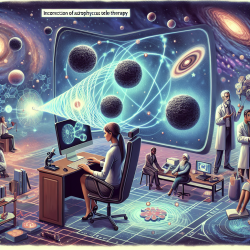At TinyEYE, we are committed to leveraging the latest research to enhance our online therapy services for schools. A fascinating study titled Search for dark matter in events with heavy quarks and missing transverse momentum in pp collisions with the ATLAS detector by the ATLAS Collaboration at CERN offers groundbreaking insights that can be translated into practical applications in online therapy. Here’s how you, as a practitioner, can implement these findings to improve your skills and encourage further research.
Understanding the Research
The study explores the search for dark matter by analyzing events with heavy quarks and missing transverse momentum. While the primary focus is on particle physics, the methodologies and analytical techniques used can provide valuable insights for improving data analysis and pattern recognition in online therapy sessions.
Applying Research Outcomes to Online Therapy
Here are some key takeaways from the research and how you can apply them to enhance your online therapy practices:
- Data Analysis Techniques: The advanced data analysis techniques used in the research can be adapted to analyze student progress and therapy outcomes more effectively. By employing similar methodologies, you can identify patterns and trends that might otherwise go unnoticed.
- Pattern Recognition: Just as the research identifies specific patterns in particle collisions, you can develop better tools for recognizing patterns in student behavior and responses during therapy sessions. This can lead to more personalized and effective therapy plans.
- Technological Integration: The use of sophisticated technology in the research underscores the importance of integrating advanced tools in online therapy. Utilizing AI and machine learning algorithms can help in automating routine tasks, thereby allowing you to focus more on direct student interaction.
Encouraging Further Research
The intersection of particle physics and online therapy might seem unconventional, but it opens up new avenues for innovative research. Here are some ways to encourage further research:
- Collaborative Studies: Partner with universities and research institutions to explore how techniques from different fields can be adapted for online therapy. This could lead to the development of new tools and methodologies.
- Interdisciplinary Conferences: Attend and present at interdisciplinary conferences to share your findings and learn from others. This will help in building a network of professionals interested in similar research areas.
- Publishing Findings: Document and publish your research in journals and online platforms. This not only contributes to the body of knowledge but also opens up opportunities for peer review and collaboration.
Conclusion
The research on dark matter and heavy quarks might be rooted in particle physics, but its analytical techniques and technological advancements have profound implications for online therapy. By integrating these insights, you can enhance your practice, contribute to innovative research, and ultimately improve outcomes for students.
To read the original research paper, please follow this link: Search for dark matter in events with heavy quarks and missing transverse momentum in pp collisions with the ATLAS detector.










